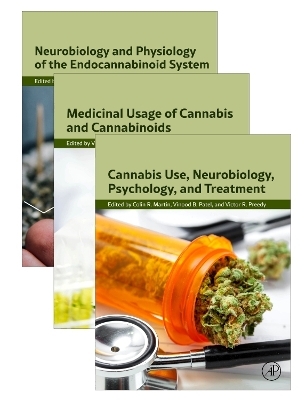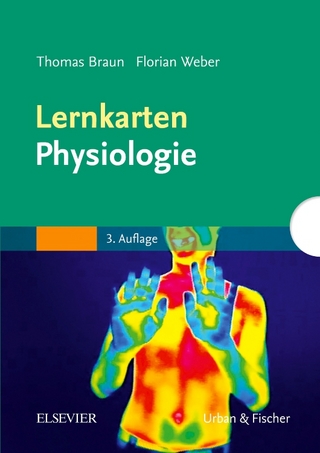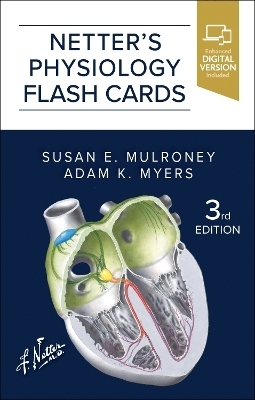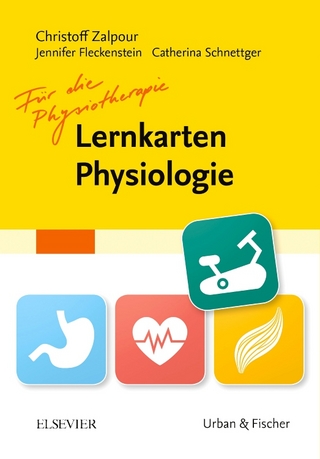
Cannabis, Cannabinoids, and Endocannabinoids
Academic Press Inc
978-0-443-18759-9 (ISBN)
Unique case reports are also provided, creating a platform for research on the use of these compounds in improving patient care, brain function and neurological dysfunction. As the endocannabinoid system has been implicated in various neurological conditions, this book is a welcomed resource on the topics presented.
Colin R. Martin RN, BSc, MSc, PhD, MBA, YCAP, FHEA, C.Psychol, AFBPsS, C.Sci is Professor of Clinical Psychobiology and Applied Psychoneuroimmunology and Clinical Director of the Institute of Health and Wellbeing at the University of Suffolk, UK. He is a Chartered Health Psychologist and a Chartered Scientist. He also trained in analytical biochemistry, this aspect reflecting the psychobiological focus of much of his research within mental health. He has published or has in press well over 300 research papers and book chapters. He is a keen book author and editor having written and/or edited more than 50 books. These outputs include the prophetic insight into the treatment of neurological disease, Handbook of Behavior, Food and Nutrition (2011), Nanomedicine and the Nervous System (2012), Oxidative Stress and Dietary Antioxidants in Neurological Disease (2020), Zika Virus Impact, Diagnosis, Control and Models (2021), Factors Affecting Neurodevelopment: Genetics, Neurology, Behavior and Diet (2021), Diagnosis and Treatment of Spinal Cord Injury (2022), The Neurobiology, Physiology, and Psychology of Pain (2022) and The Handbook of Lifespan Cognitive Behavioral Therapy: Childhood, Adolescence, Pregnancy, Adulthood, and Aging (2023). Professor Martin is particularly interested in all aspects of the relationship between underlying physiological substrates and behavior, particularly in how these relationships manifest in both acute and chronic psychiatric disorder. He has published original research germane to significant mental health disorders including the areas of schizophrenia, anxiety, depression, self-esteem, alcohol and drug dependency, high secure forensic mental health and personality disorder. He has a keen interest in the impact of postviral illness and is actively involved in clinical research post-Covid pandemic and in particular, the impact of Long Covid on psychological, neurological, physiological and social functioning. He is involved in collaborative International research with many European and Non-European countries. Dr. Patel is a Reader at the University of Westminster. After completing his PhD at King’s College London, he continued his research experience by undertaking his post-doctoral studies in the laboratory of Professor Cunningham in the Department of Biochemistry at the Wake Forest University School of Medicine, (Winston-Salem, NC, USA). This extensive project involved investigating mechanisms of hepatic mitochondrial ribosome dysfunction in alcoholic liver disease (ALD) using biophysical and proteomic techniques. These studies have led to new avenues in determining the pathology of ALD. His teaching areas at both post-graduate and undergraduate levels include clinical biochemistry, investigative pathology and laboratory investigation. Victor R. Preedy BSc, PhD, DSc, FRSB, FRSPH, FRSC, FRCPath graduated with an Honours Degree in Biology and Physiology with Pharmacology. After gaining his University of London PhD, he received his Membership of the Royal College of Pathologists. He was later awarded his second doctorate (DSc), for his contribution to protein metabolism in health and disease. He is Professor of Clinical Biochemistry (Hon) at King’s College Hospital and Emeritus Professor of Nutritional Biochemistry at King’s College London. He has Honorary Professorships at the University of Hull, and the University of Suffolk. Professor Preedy was the Founding Director and then long-term Director of the Genomics Centre at King’s College London from 2006 to 2020. Professor Preedy has been awarded fellowships of the Royal Society of Biology, the Royal College of Pathologists, the Royal Society for the Promotion of Health, the Royal Institute of Public Health, the Royal Society for Public Health, the Royal Society of Chemistry and the Royal Society of Medicine. He carried out research when attached to the National Heart Hospital (part of Imperial College London), The School of Pharmacy (now part of University College London) and the MRC Centre at Northwick Park Hospital. He has collaborated with international research groups in Finland, Japan, Australia, USA, and Germany. To his credit, Professor Preedy has published over 750 articles, which includes peer-reviewed manuscripts based on original research, abstracts and symposium presentations, reviews and edited books.
Cannabis Use, Neurobiology, Psychology, and TreatmentI. Setting the scene and introductory chapters1. Metabolomics of the cannabis plant; 2. The roots of Cannabis sativa: chemical and pharmacological profile; 3. Cannabis related compounds in beverages and food; 4. The impact of prenatal cannabis exposure: an overview; 5. Cannabinoid Genotoxicity and Congenital Anomalies: A Convergent Synthesis of European and USA Datasets; 6. Cannabis Genotoxicity and Cancer Incidence: A Highly Concordant Synthesis of European and USA Datasets; 7. Cannabis, Cognitive impairment and Car Crash risk
II. Cannabis usage8. Recreational cannabis use: a French perspective of adverse effects; 9. Acute and chronic impact of cannabis on human cognition; 10. Polydrug users, use of cannabidiol (CBD) and abuse potential/Polydrug users, use of cannabinoids and abuse potential; 11. Cannabis stigmas: a narrative of features; 12. Alterations of THC and CBD ratios and impact on cognition; 13. When cannabis is used for medicinal purposes: a focus on back pain
III. Pharmacological and Physiological Aspects14. Cannabis, cannabinoids and receptor responses; 15. Cannabidiol (CBD): abuse potential and withdrawal; 16. 4,5- Dihydro-1H-pyrazole/3,4-Diarylpyrazoline class of cannabinoid-1 (CB1R) receptor antagonists and their potential in medicinal applications
IV. Neurobiology of cannabis17. Neurobiology of cannabis; 18. The kynurenine pathway, neurobiology and cannabis misuse: a new narrative; 19. Central nervous system cancers and use of cannabis and related products: an updated narrative; 20. Chronic cannabis users: links with glutamate and resting state connectivity; 21. Brain metabolic responses to cannabis use in people with multiple sclerosis: Insights from [18F]-FDG positron emission tomography and functional MRI; 22. Genetic Variation and Acute Responses to Cannabis; 23. Cell Signaling of the CB1 Cannabinoid Receptor via beta-arrestins, Cannabinoid Receptor Interacting Protein (CRIP1a) and other regulatory proteins; 24. Cannabis and impact on memory: from in utero to adults; 25. Central CB1 receptors and age-related changes: investigating the effects of DELTA-9-tetrahydrocannabinol; 26. Alcohol, cannabis and visual memory
V. Neurobiology of cannabinoids27. The role of Delta-FosB in the plasticity of the cannabinoid system; 28. Functional profile of synthetic cannabinoid receptor agonists: exploring cannabinoid and non-cannabinoid targets; 29. Linking the G protein-coupled orphan receptor GPR55 to the cannabinoid receptors (CB1 and CB2): a new narrative; 30. Proteomic analysis of cannabinoids in human oligodendrocytes; 31. Cannabinoids and endocannabinoid signaling at the basal forebrain cholinergic system; 32. Cannabidiol (The major non-psychotropic cannabinoid in the cannabis plant) and the PI3K/Akt pathway in the CNS; 33. Effects of cannabidiol and other phytocannabinoids on ion channels;34. Cannabis, neurodevelopment and the "two-hit hypothesis"
VI. New and synthetic cannabinoids35. Impact of tetrahydrocannabinol (THC ) and synthetic "spice"cannabinoids on nicotine use and abuse; 36. Synthetic cannabinoids: how do they compare to DELTA9-tetrahydrocannabinol: neurological effects and beyond
VII. Biomarkers, analysis and screening37. The DSM-5 criteria of cannabis use disorder: methods and applications; 38. Cannabis and clinical high risk for psychosis: monitoring and smartphones
VIII. Impact on non-neurological systems39. The impact of cannabis and cannabinoids on the skin; 40. Cannabis consumption in reproduction and teratogenicity; 41. Cannabis compounds and putative cytotoxicity: profile of cancer cells
IX. Treatments, strategies and resources42. Motivational Interviewing for Cannabis Use Disorders: a narrative review from research to practice; 43. An Overview of Current Pharmacologic Interventions for Management of Cannabis Withdrawal and the Evidence for Their Use; 44. Managing cannabinoid hyperemesis syndrome in paediatrics: A new narrative review; 45. Gabapentinoids for the Treatment of Cannabis Use Disorder: A Focus on Human Laboratory Research; 46. Treating psychosis in users of synthetic cannabinoids
X. Resources47. Cannabis and Web based Resources
Medicinal Usage of Cannabis and CannabinoidsI. Setting the scene and introductory chapters1. How medical cannabis may influence the future of medicine; 2. Medical cannabis and cannabinoids: how best to extract components from plant material; 3. Medicinal usage of cannabis and its impact on mental health among cancer patients and survivors; 4. Cannabis sativa as a traditional phytomedicine: a new narrative covering different countries; 5. Medical use of cannabis in the middle east; 6. What medicinal cannabis is used for: a focus on Canada; 7. New York perspectives of medical cannabis laboratory analysis; 8. Epigenetic regulations on the quality of clonal cannabis plants: secondary metabolites and profiles; 9. Aberrant use of medicinal cannabis: theoretical and empirical considerations; 10. Profile of older users of medical cannabis and cannabinoids; 11. Use of cannabidiol oil by caregivers: a focus on Alzheimer's disease; 12. Medicinal use of cannabis: adverse events as a balanced perspective
II. Physiological aspects and metabolic aspects13. Physiopathology and use of cannabinoids for fibrotic diseases; 14. Cannabinoids in inflammation and atherosclerosis; 15. Targeting the CB(2) receptors and other endocannabinoid elements to delay disease progression in cardiovascular diseases; 16. BMI in cannabis users: regulation, mechanisms and public health impact
III. Neurological, psychological and behavioural aspects17. Neuroprotection by cannabis related products, cannabidiol and cannabigerol, and associated mechanisms of action; 18. Cannabis terpenes as neuroprotective agents: a focus on alpha-bisabolol; 19. Cannabidiol in medicinal usage of stress: modelling investigations into cocaine; 20. Medicinal cannabis and neurocognition impairment; 21. Genetic models of audiogenic seizures: what they are and how cannabinoids and Cannabis-derived compounds can be used to alleviate their symptoms - an updated narrative; 22. Addressing the validity of cannabinoid therapy as an option for the treatment of substance use disorder
IV. Pharmacological and cellular aspects23. Cannabidiolic acid (CBDA), features and profiles: anti-hyperalgesic effects; 24. Cannabis-drug interactions: implications for medicinal cannabis use; 25. Cannabinoid receptor subtype 2 (CB2R): features and targets for medical applications; 26. Medical use of cannabidiol and impact on cancer cell viability; 27. Anti-inflammatory and antioxidant and immunomodulatory effects of phytocannabinoid -caryophyllene: A mechanistic overview
V. Symptom Control and Medicinal Uses28. Cancer patients and providers: Attitudes and beliefs of cannabis and cannabinoids use as a treatment; 29. CBD (cannabidiol) use in breast cancer chemotherapy; 30. Sleep: cannabis and cannabinoids use; 31. Cannabis and cannabis related products and their uses in aiding sexual health of men and women; 32. Symptom control in palliative care settings: The role of cannabis-based medicines; 33. Cannabidiol (CBD) Use in Fragile X Spectrum Disorders; 34. Hempseed (Cannabis sativa) and ameliorative effects in hypercholesterolemia; 35. Benzodiazepines and cannabis use; 36. Features of (+)-trans-cannabidiol-2-hydroxy pentyland applications to disease: a focus on usage in diabetic nephropathy; 37. Medical use of cannabis: applications to Tourette syndrome; 38. Cannabinoids and their use in chronic non-cancer pain: a new narrative review; 39. Endometriosis: features and potential role of medical cannabis; 40. Cannabis usage for Crohn's disease and ulcerative colitis: a narrative; 41. Medical cannabis and use in migraine; 42. Cannabidiol (CBD ) and potential in medicinal use in rheumatoid arthritis; 43. Role of Cannabinoids in Glaucoma: Lowering Intraocular Pressure or Neuroprotection; 44. Medicinal potential of anandamide as a representative endocannabinoid and its effect at the cellular level in skin
VI. Resources45. Medical Cannabis and Resources
Neurobiology, Physiology, And The Endocannabinoid SystemI. Setting the scene and introductory chapters1. Distribution of the endocannabinoid system: linking signalling and development; 2. The endocannabinoid system, immunomodulation, and LPS-induced inflammation; 3. Physiology of the endocannabinoid systems: imaging and the use of positron emission tomography (PET); 4. The endocannabinoid system and aging; 5. The endocannabinoid system and post traumatic stress disorder (PTSD): a new narrative
II. Neurobiology of the endocannabinoid system6. The protective effect of the endocannabinoid system in neurotoxin induced damage to hippocampal neurons: a focus on light and electron microscopy; 7. Endocannabinoid Signaling and excitatory and inhibitory synapses; 8. The endocannabinoids and potassium channels: an updated narrative; 9. Social interactions and neural activity: linking cellular studies and endocannabinoid signalling; 10. Exercise and Parkinson's disease: linking in the cannabinoid type 1 (CB1) and type 2 (CB2), and mu-opioid receptors; 11. The endocannabinoids system and endocannabinoid receptors in sleep; 12. Endocannabinoids and inhalant misuse: neuropsychological aspects; 13. Fatty acid amide hydrolase (FAAH) in substance use disorders: FAAH regulation and inhibition in cannabis, alcohol, nicotine, stimulant, and opioid use disorders; 14. Treatment of pain with dual fatty acid amide hydrolase (FAAH) enzyme and human soluble epoxide hydrolase (sEH) enzyme inhibitors: interlinking the endocannabinoid system; 15. WWL70: linking the hydrolyses 2-arachidonoylglycerol, endocannabinoid and eicosanoid pathways: therapeutic potential and neurological disease; 16. Endocannabinoid catabolic enzyme inhibitors and pain alleviation; 17. The endocannabinoid system in health and disease: features in epilepsy; 18. The endocannabinoid system and autoimmune demyelination: a focus on multiple sclerosis; 19. Endocannabinoid signaling and the lateral habenula; 20. On the interplay among endocannabinoid, noradrenergic and glucocorticoid systems: evidence from aversive memory studies
III. Receptor biology and responses 21. Adenosine A2A-cannabinoid CB1 receptor heteromers in the brain: From trans-inhibition to trans-activation; 22. Hippocampal CB1, CB2 receptors, the endocannabinoid system and fear memory; 23. Beta-caryophyllene, the CB2 cannabinoid receptor-specific agonists and wound healing; 24. The nigrostriatal dopaminergic pathway: impact of WIN 55212-2 as a potent cannaboinoid receptor agonist; 25. Peripheral cannabinoid receptor 1 antagonists and impact on adipocytes; 26. Endocannabinoid system receptors in plasma membranes : extraction, lipid rafts and the cortex; 27. Applications to wound healing: cannabinoid receptor 1 antagonism and collagen deposition; 28. Role of the Transient Receptor Potential Vanilloid 1 (TRPV1), a component of the endocannabinoid system, in anxiety, depression, and cocaine addiction; 29. Allosteric modulators of the endocannabinoid system: Org27569 and cannabinoid receptor 1 (CB1); 30. Naturally occurring DELTA-9-tetrahydrocannabinol-derivatives and binding to CB1 and CB2 receptors: Linking in the endocannabinoid system
IV. Profiles and behaviour of selective endocannabinoids31. New cannabinoid receptor type 1 and 2 agonists and applications to understanding the endocannabinoid system; 32. Fatty acid amide hydrolase, the endocannabinoid anandamide and neurological disease; 33. The endocannabinoid-system in the immuno-biology of dendritic cells; 34. Palmitoylethanolamide and other anandamide congeners in neuroinflammation-based disorders: linking in the endocannabinoid system; 35. Endocannabinoid modulation of synaptic function and behavior in the dorsomedial hypothalamus; 36. Key role of anandamide and the endocannabinoid system in the modulation of cardio-renal homeostasis; 37. The endocannabinoid system: Signaling and social motivation
V. Exogenous, synthetic other compounds linking in the endocannabinoid system38. Safety and toxicology of the dietary cannabinoid beta-caryophyllene; 39. Synthetic cannabimimetics: an overview
VI. Compartive studies in non neurological systems 40. Non Neurological Aspects of the Endocannabinoid System: Non Alcoholic Fatty Liver Disease; 41. Components of the Endocannabinoid system: Hepatic expression levels of the cannabinoid receptors and microRNAs; 42. Tumour growth and the endocannabinoid system: investigating CB2 agonists; 43. Linking Endocannabinoid System, Palmitoylethanolamide and Sarcopenia in view of therapeutic outcomes
VII. Resources44. Endocannabinoids and Resources
| Erscheint lt. Verlag | 13.10.2023 |
|---|---|
| Verlagsort | San Diego |
| Sprache | englisch |
| Maße | 216 x 276 mm |
| Gewicht | 5840 g |
| Themenwelt | Medizin / Pharmazie ► Medizinische Fachgebiete ► Neurologie |
| Studium ► 1. Studienabschnitt (Vorklinik) ► Physiologie | |
| Naturwissenschaften ► Biologie ► Humanbiologie | |
| Naturwissenschaften ► Biologie ► Zoologie | |
| ISBN-10 | 0-443-18759-2 / 0443187592 |
| ISBN-13 | 978-0-443-18759-9 / 9780443187599 |
| Zustand | Neuware |
| Informationen gemäß Produktsicherheitsverordnung (GPSR) | |
| Haben Sie eine Frage zum Produkt? |
aus dem Bereich


